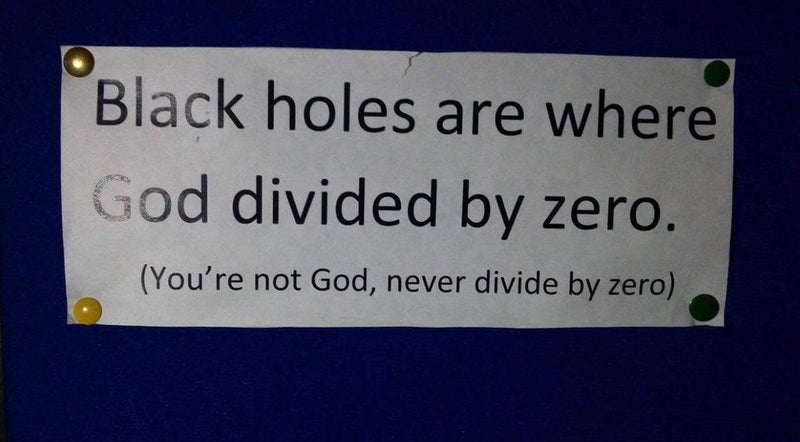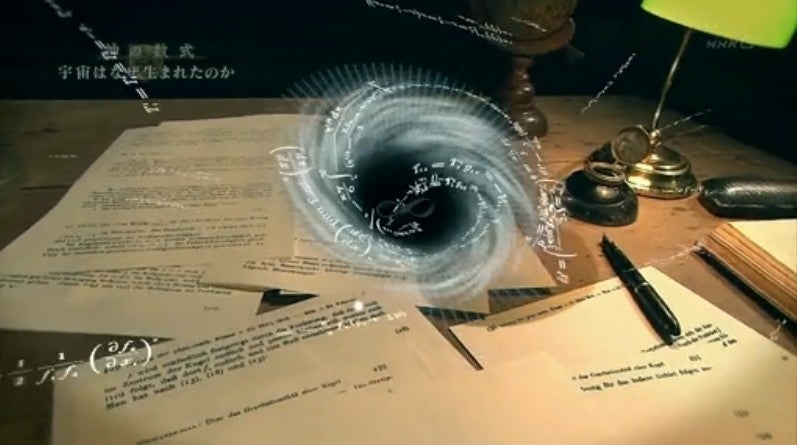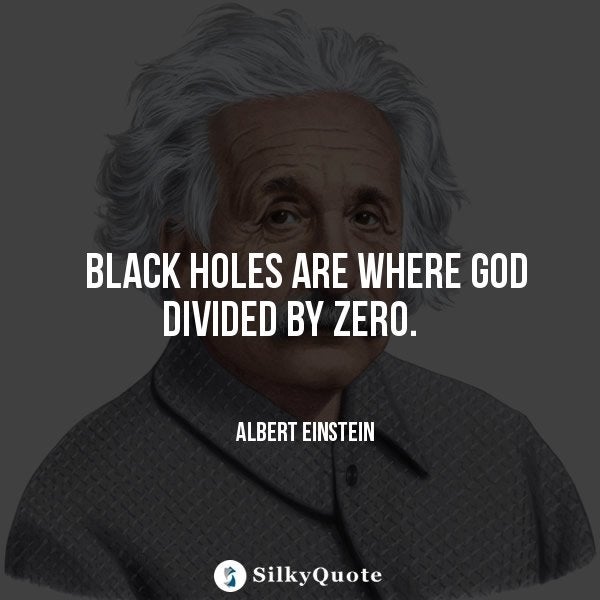BLACK HOLES: WHERE GOD DIVIDED BY ZERO
Imagine you are in a technologically advanced interstellar spaceship. You and your team have just successfully passed through a wormhole and reached a different galaxy. This galaxy looks quite promising. Several nearby hospitable planets seem like possible candidates for terraforming – altering their atmospheres and other properties to be more Earth-like, so that they might sustain life. Perfect for saving the human race from extinction and ensuring the ongoing survival into the indefinite future. Only there’s one problem: there is a massive black hole that is making your mission much more complicated – and also, much more dangerous!
Artist’s depiction of a black hole with a large accretion disk and a jet of gamma rays bursting outward. Image is licensed under creative commons.
Such a scenario is the main theme of the popular 2014 movie Interstellar. Also featured in a host of other movies that have reached the mainstream media, black holes are becoming increasingly popular among non-scientist audiences. This is indeed quite excellent and exciting for a black hole enthusiast such as myself. But with this growing interest in modern physics among general audiences, misconceptions and misunderstandings often arise, as the basics of black hole theory are not explained in an adequate manner.
Let’s start at the beginning – the end of a super-giant star. As far as stars go, the larger they are, the shorter they live and the more massive the resulting explosion – called a supernova. When a super-giant star, one much larger than our Sun, enters it’s final stages, it will have used up all the fuel available to it. That is to say, stars fuse smaller elements into larger ones through a process called stellar nucleosynthesis. Again, the more massive a star is the larger the elements that can be used as a fuel source. There is a limit, however, which is set at iron – the 26th element on the periodic table. All the elements up to and including iron on the periodic table will yield energy as a result of fusing them together. Whereas if you try to fuse elements that are beyond iron on the periodic table, you will need to supply energy. Nature has chosen iron to be the dividing element.
So a supermassive star, having used up all of the fuel at its core and converted it to iron, will explode and shed most of it’s mass into interstellar space. This process creates all of the other elements on the periodic table. These particles gather and form into the next generation of stars, planets, and other cosmic bodies. Indeed, as famously said by Carl Sagan, this makes all of us star dust. We are the product of stellar evolution and recycling. But let’s get back to the topic at hand.
After the explosion, a large iron chunk remains, which was once the core of the star. If this iron chunk is about three or four times the mass of our Sun, it will collapse into itself. But why? It’s a simple balance of interplaying forces. While the star is still active, the fusion process of making heavier elements from lighter ones will create an outward pressure. This outward pressure is balanced by the inward pressure of gravity., This makes a star stable during this stage in time. However, gravity always wins. When the fuel runs out, the outward pressure relaxes (after the massive supernova explosion) and there is nothing left to stop the enormous gravitational forces from collapsing the remnant iron core. But why in particular does this only happen at the limit of about three to four times the mass of our Sun?
If the remnant mass after the end of a star is less than this limit (called the Tolman-Oppenheimer-Volkoff, or TOV limit), then the collapse is stopped by quantum forces. Depending on the exact mass of the remnant, objects like dwarf stars, neutron stars, and possibly even quark stars may be created. A dwarf star, for example, is the fate of our humble Sun. A neutron star is also very interesting. When a star is just slightly less than the TOV limit, the electrons of each atom in the remnant are forcefully squeezed into the nuclei, creating a vast amount if neutrons. Such a star is very dense and heavy. Often, they spin at a very regular and fast rate, and are then called pulsars.
However, the TOV limit says that even the forces of quantum mechanics cannot hold up against the immense forces of an iron core with three to four times the mass of the Sun. So if no force can stop a collapse, there is only one thing left which can occur: a collapse! The remnant is squeezed into itself. First, the electrons fall into the nuclei, and then the matter falls even further. This happens at an incredible rate: the collapsing mass falls into a single point of zero volume (hold that thought – to be addressed next paragraph), creating a (gravitational) singularity. A singularity is the centre of a black hole, and it has infinite density. If you recall basic high school physics, the density of an object is just its mass divided by its volume. But when the volume is zero (a single point), division by zero occurs! Dividing by zero surely creates an infinite value. This inspired the name of this article.
Now we have a problem. The possibility of singularities creates two schools of physicists: the ones that believe in them and the ones that do not. The majority of them do not, and regard singularities as unphysical objects. Albeit, we must admit that anything that happens inside a black hole is beyond certainty. There has been a large effort over the decades to resolve singularities by introducing more quantum forces into the equations of relativity. These quantum forces don’t appear until vast pressures and tiny volumes come into play. They are not thought to stop a black hole from forming in the first place, but are hypothesized to prevent the singularity. Basically, they prevent the division by zero.
Equation of a Schwarzschild black hole – the simplest types of all black hole solutions. This black hole does not rotate, have charge, nor evolve in time. It is unchanging yet elegant. Image owned by author.
Before we end, a quick note on certainty should be made, as people are often curious or even skeptical about how physicists know all these things about black holes while no black hole has ever been directly observed. In 1915, Albert Einstein published several remarkable papers outlining his theory of general relativity (general refers to the entire encompassing theoretical framework, whereas special relativity, which was formulated a decade prior, is a subset of general relativity and deals with time, length and velocities). This theory overthrew the Newtonian way of thinking about space, time, light and gravity. To date, Einstein’s relativity theory has been subjected to countless tests and experiments and has repeatedly shown to agree with observations to a high degree of accuracy. It was shortly later, in 1916, that the first black hole solution was discovered hidden inside Einstein’s equations. The solution was found by German physicist Karl Schwarzschild while he was fighting in the front line infantry during the first world war. He later died of a rare autoimmune disease.
Schwarzschild’s solution for a black hole, which late came to bare his name in honour of his work, is the simplest of all of the black hole solutions that were later found. Since his time, black holes have been extensively studied by famous physicists, of whom the most notable is Stephen Hawking. His work has given us great insight into the outer and inner workings of black holes. Many properties of black holes have been discovered, and strong secondary evidence of their existence has also been found. (Secondary evidence of black holes consists of observations of the effects caused by the doings of black holes, e.g., the gravitational force of the black hole on nearby stars, which will deform their orbit in a predictable manner (make link to video), or light passing nearby a black hole, which will be deflected in a calculable way.).
So although we have a good understanding on what goes on outside of the black hole, the inside is much more uncertain. This is because the black hole is…well…black. Well, actually that is not entirely true. Hawking has shown that black holes actually radiate at a very low rate. This radiation is named after Hawking and sometimes after his student Beckenstein as well.
Now that we have established the formation of black holes, the properties of black holes ought to be discussed next. Black holes have an edge, and a mass, and a spin; they could, in principle, have an electrical charge as well. They, as mentioned, radiate energy back into interstellar space. Black holes also break all of our intuition for when the edge of the black hole is crossed. At first black holes were regarded as the simplest objects in space, but they have since shown to be the most complicated. All this and more is to be discussed in a following article!
*****
If these ideas get you excited and you are bursting with enthusiasm, I encourage you to start a discussion here. Please feel free to ask questions and share your excitement with your friends.https://theamateurrealist.wordpress.com/2014/11/27/black-holes-where-god-divided-by-zero/
Wasan Geometry and Division by Zero Calculus
2018年11月28日(水) テーマ:数学
Sangaku Journal of Mathematics (SJM) ⃝c SJM ISSN 2534-9562 Volume 2 (2018), pp. 57-73 Received 20 November 2018. Published on-line 29 November 2018 web: http://www.sangaku-journal.eu/ ⃝c The Author(s) This article is published with open access1 . Wasan Geometry and Division by Zero Calculus
file:///C:/Users/saito%20saburo/Downloads/SJM_2018_57-73_okumura_saitoh%20(1).pdf
ゼロ除算の発見は日本です:
∞???
∞は定まった数ではない・・・・
人工知能はゼロ除算ができるでしょうか:
とても興味深く読みました:2014年2月2日 4周年を超えました:
ゼロ除算の発見と重要性を指摘した:日本、再生核研究所
ダ・ヴィンチの名言 格言|無こそ最も素晴らしい存在
ゼロ除算の発見はどうでしょうか:
Black holes are where God divided by zero:
再生核研究所声明371(2017.6.27)ゼロ除算の講演― 国際会議
https://ameblo.jp/syoshinoris/entry-12287338180.html
1/0=0、0/0=0、z/0=0
http://ameblo.jp/syoshinoris/entry-12276045402.html
1/0=0、0/0=0、z/0=0
http://ameblo.jp/syoshinoris/entry-12263708422.html
1/0=0、0/0=0、z/0=0
http://ameblo.jp/syoshinoris/entry-12272721615.html
Division By Zero(ゼロ除算)1/0=0、0/0=0、z/0=0
ゼロ除算(ゼロじょざん、division by zero)1/0=0、0/0=0、z/0=0
ソクラテス・プラトン・アリストテレス その他
https://ameblo.jp/syoshinoris/entry-12328488611.html
ドキュメンタリー 2017: 神の数式 第2回 宇宙はなぜ生まれたのか
https://www.youtube.com/watch?v=iQld9cnDli4
〔NHKスペシャル〕神の数式 完全版 第3回 宇宙はなぜ始まったのか
https://www.youtube.com/watch?v=DvyAB8yTSjs&t=3318s
〔NHKスペシャル〕神の数式 完全版 第1回 この世は何からできているのか
https://www.youtube.com/watch?v=KjvFdzhn7Dc
NHKスペシャル 神の数式 完全版 第4回 異次元宇宙は存在するか
https://www.youtube.com/watch?v=fWVv9puoTSs
再生核研究所声明 411(2018.02.02): ゼロ除算発見4周年を迎えて
https://ameblo.jp/syoshinoris/entry-12348847166.html
再生核研究所声明 416(2018.2.20): ゼロ除算をやってどういう意味が有りますか。何か意味が有りますか。何になるのですか - 回答
再生核研究所声明 417(2018.2.23): ゼロ除算って何ですか - 中学生、高校生向き 回答
再生核研究所声明 418(2018.2.24): 割り算とは何ですか? ゼロ除算って何ですか - 小学生、中学生向き 回答
再生核研究所声明 420(2018.3.2): ゼロ除算は正しいですか,合っていますか、信用できますか - 回答
2018.3.18.午前中 最後の講演: 日本数学会 東大駒場、函数方程式論分科会 講演書画カメラ用 原稿
The Japanese Mathematical Society, Annual Meeting at the University of Tokyo. 2018.3.18.
https://ameblo.jp/syoshinoris/entry-12361744016.html より
9月18日(火) 14:10~15:00
和算とゼロ除算
齋藤三郎・奥村 博
京都大学数理解析研究所 111 号室
https://note.mu/ysaitoh/n/n1d38a681644f
再生核研究所声明 424(2018.3.29): レオナルド・ダ・ヴィンチとゼロ除算
再生核研究所声明 427(2018.5.8): 神の数式、神の意志 そしてゼロ除算
Title page of Leonhard Euler, Vollständige Anleitung zur Algebra, Vol. 1 (edition of 1771, first published in 1770), and p. 34 from Article 83, where Euler explains why a number divided by zero gives infinity.
私は数学を信じない。 アルバート・アインシュタイン / I don't believe in mathematics. Albert Einstein→ゼロ除算ができなかったからではないでしょうか。
1423793753.460.341866474681。
Einstein's Only Mistake: Division by Zero
神の数式:
神の数式が解析関数でかけて居れば、 特異点でローラン展開して、正則部の第1項を取れば、 何時でも有限値を得るので、 形式的に無限が出ても 実は問題なく 意味を有します。
物理学者如何でしょうか。
カテゴリ:カテゴリ未分類
そこで、計算機は何時、1/0=0 ができるようになるでしょうか。 楽しみにしています。 もうできる進化した 計算機をお持ちの方は おられないですね。
これは凄い、面白い事件では? 計算機が人間を超えている 例では?
面白いことを発見しました。 計算機は 正しい答え 0/0=0
を出したのに、 この方は 間違いだと 言っている、思っているようです。
0/0=0 は 1300年も前に 算術の発見者によって与えられたにも関わらず、世界史は間違いだと とんでもないことを言ってきた。 世界史の恥。 実は a/0=0 が 何時も成り立っていた。 しかし、ここで 分数の意味を きちんと定義する必要がある。 計算機は、その意味さえ知っているようですね。 計算機、人間より賢くなっている 様が 出て居て 実に 面白い。
https://steemkr.com/utopian-io/@faisalamin/bug-zero-divide-by-zero-answers-is-zero
2018.10.11.11:23
カテゴリ:カテゴリ未分類
面白いことを発見しました。 計算機は 正しい答え 0/0=0
を出したのに、 この方は 間違いだと 言っている、思っているようです。
0/0=0 は 1300年も前に 算術の発見者によって与えられたにも関わらず、世界史は間違いだと とんでもないことを言ってきた。 実は a/0=0 が 何時も成り立っていた。しかし、ここで 分数の意味を きちんと定義する必要がある。 計算機は、その意味さえ知っているようですね。 計算機、人間より賢くなっている様が 出て居て 実に面白い。
https://steemkr.com/utopian-io/@faisalamin/bug-zero-divide-by-zero-answers-is-zero
2018.10.11.11:23
ゼロ除算、ゼロで割る問題、分からない、正しいのかなど、 良く理解できない人が 未だに 多いようです。そこで、簡潔な一般的な 解説を思い付きました。 もちろん、学会などでも述べていますが、 予断で 良く聞けないようです。まず、分数、a/b は a 割る b のことで、これは 方程式 b x=a の解のことです。ところが、 b がゼロならば、 どんな xでも 0 x =0 ですから、a がゼロでなければ、解は存在せず、 従って 100/0 など、ゼロ除算は考えられない、できないとなってしまいます。 普通の意味では ゼロ除算は 不可能であるという、世界の常識、定説です。できない、不可能であると言われれば、いろいろ考えたくなるのが、人間らしい創造の精神です。 基本方程式 b x=a が b がゼロならば解けない、解が存在しないので、困るのですが、このようなとき、従来の結果が成り立つような意味で、解が考えられないかと、数学者は良く考えて来ました。 何と、 そのような方程式は 何時でも唯一つに 一般化された意味で解をもつと考える 方法があります。 Moore-Penrose 一般化逆の考え方です。 どんな行列の 逆行列を唯一つに定める 一般的な 素晴らしい、自然な考えです。その考えだと、 b がゼロの時、解はゼロが出るので、 a/0=0 と定義するのは 当然です。 すなわち、この意味で 方程式の解を考えて 分数を考えれば、ゼロ除算は ゼロとして定まる ということです。ただ一つに定まるのですから、 この考えは 自然で、その意味を知りたいと 考えるのは、当然ではないでしょうか?初等数学全般に影響を与える ユークリッド以来の新世界が 現れてきます。
ゼロ除算の誤解は深刻:
最近、3つの事が在りました。
私の簡単な講演、相当な数学者が信じられないような誤解をして、全然理解できなく、目が回っているいるような印象を受けたこと、
相当ゼロ除算の研究をされている方が、基本を誤解されていたこと、1/0 の定義を誤解されていた。
相当な才能の持ち主が、連続性や順序に拘って、4年以上もゼロ除算の研究を避けていたこと。
これらのことは、人間如何に予断と偏見にハマった存在であるかを教えている。
まずは ゼロ除算は不可能であるの 思いが強すぎで、初めからダメ、考えない、無視の気持ちが、強い。 ゼロ除算を従来の 掛け算の逆と考えると、不可能であるが 証明されてしまうので、割り算の意味を拡張しないと、考えられない。それで、 1/0,0/0,z/0 などの意味を発見する必要がある。 それらの意味は、普通の意味ではないことの 初めの考えを飛ばして ダメ、ダメの感情が 突っ走ている。 非ユークリッド幾何学の出現や天動説が地動説に変わった世界史の事件のような 形相と言える。
最近、3つの事が在りました。
私の簡単な講演、相当な数学者が信じられないような誤解をして、全然理解できなく、目が回っているいるような印象を受けたこと、
相当ゼロ除算の研究をされている方が、基本を誤解されていたこと、1/0 の定義を誤解されていた。
相当な才能の持ち主が、連続性や順序に拘って、4年以上もゼロ除算の研究を避けていたこと。
これらのことは、人間如何に予断と偏見にハマった存在であるかを教えている。
まずは ゼロ除算は不可能であるの 思いが強すぎで、初めからダメ、考えない、無視の気持ちが、強い。 ゼロ除算を従来の 掛け算の逆と考えると、不可能であるが 証明されてしまうので、割り算の意味を拡張しないと、考えられない。それで、 1/0,0/0,z/0 などの意味を発見する必要がある。 それらの意味は、普通の意味ではないことの 初めの考えを飛ばして ダメ、ダメの感情が 突っ走ている。 非ユークリッド幾何学の出現や天動説が地動説に変わった世界史の事件のような 形相と言える。
2018.9.22.6:41
ゼロ除算の4つの誤解:
ゼロ除算の4つの誤解:
1. ゼロでは割れない、ゼロ除算は 不可能である との考え方に拘って、思考停止している。 普通、不可能であるは、考え方や意味を拡張して 可能にできないかと考えるのが 数学の伝統であるが、それができない。
2. 可能にする考え方が 紹介されても ゼロ除算の意味を誤解して、繰り返し間違えている。可能にする理論を 素直に理解しない、 強い従来の考えに縛られている。拘っている。
3. ゼロ除算を関数に適用すると 強力な不連続性を示すが、連続性のアリストテレス以来の 連続性の考えに囚われていて 強力な不連続性を受け入れられない。数学では、不連続性の概念を明確に持っているのに、不連続性の凄い現象に、ゼロ除算の場合には 理解できない。
4. 深刻な誤解は、ゼロ除算は本質的に定義であり、仮定に基づいているので 疑いの気持ちがぬぐえず、ダメ、怪しいと誤解している。数学が公理系に基づいた理論体系のように、ゼロ除算は 新しい仮定に基づいていること。 定義に基づいていることの認識が良く理解できず、誤解している。
George Gamow (1904-1968) Russian-born American nuclear physicist and cosmologist remarked that "it is well known to students of high school algebra" that division by zero is not valid; and Einstein admitted it as {\bf the biggest blunder of his life} [1]:1. Gamow, G., My World Line (Viking, New York). p 44, 1970.
Eπi =-1 (1748)(Leonhard Euler)
1/0=0/0=0 (2014年2月2日再生核研究所)
ゼロ除算(division by zero)1/0=0/0=z/0= tan (pi/2)=0
https://ameblo.jp/syoshinoris/entry-12420397278.html
1+1=2 ( )
a2+b2=c2 (Pythagoras)
1/0=0/0=0(2014年2月2日再生核研究所)


































0 件のコメント:
コメントを投稿